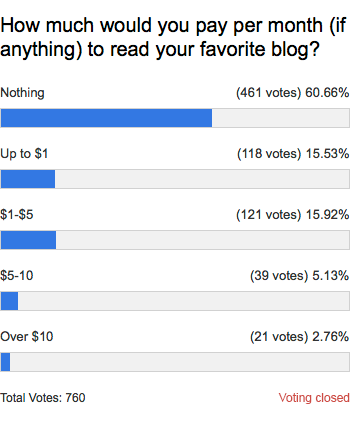Just something I’ve been thinking about–would love to get your comments and responses to this. Do you have a favorite blog that you read regularly, maybe every day, maybe every week? A blog that consistently delivers new content that you derive a lot of value from? If so, would you pay to read it? Take the poll:

Monetization of online content is of course a big issue right now, with newspapers, magazines and blogs trying out different models. Most blog content today of course is free, with revenue coming from advertising. Web CPM (cost to the advertiser for 1000 impressions, or pageviews) is much lower than that of print media.
This makes advertising based revenue models not very lucrative, and leads to the litter of ad banners you see on many sites. It also leads to poor, traffic magnet content. Advertisers pay for pageviews, so they get pageviews. Of course on the flip side, advertisers don’t really want pageviews, they want a certain demographic to see their ad–they want to convert visitors to customers, and they can’t do that if the traffic is poor and untargeted. That’s one of the reasons for the low CPM–the traffic is just not worth a very much.
But the thing is, while there are a lot of poor, low quality blogs out there, there are also some really great ones. Some blogs are so good their content gets turned into books–great books that also sell well (examples: Joel on Software, Signal vs Noise, Seth Godin’s blog). People pay for the books, but they don’t pay for the blogs, even though the content is the same (and there’s much more of it).
Could blogs, magazines and other content based sites actually charge readers a subscription rate? Some already do of course. Ars Technica have a premium section. Envato publishes premium tutorials on their TutsPlus network. And of course, large publications like the Wall Street Journal also have premium content that requires a subscription for access. Even so, the sites that offer premium subscription models are in the tiny minority.
###Paid blog network?
Here’s an idea. I don’t think people will want to pay a lot to read blogs. People aren’t going to pay tiny rates to read individual blogs either (e.g. $0.50 a month) because micropayments are just too messy. They cost a lot to process for the seller and present a problem for the buyer where they have to make a decision. The content is almost free, but yet it isn’t–they have to get the wallet out. Most won’t bother.
What about this: you pay $10 a month, but instead of subscribing to just one blog, you get a subscription to a whole blog network, say 50 blogs or more. The network could then distribute the money proportionally based on the paid traffic these blogs and sites get. The readers get the benefit of paying a small monthly fee to access a multitude of blogs. No micropayments, no multiple subscriptions.
Each site in the network could have a premium section and a free section. Most content could be published in the free section to get advertising revenue and attract new readers (or maybe the other way round, more content for paid readers). Some of the best content could be promoted to the premium section, which will also see regular updates.
I don’t know if anyone has tried to do this yet, but I think something like this could work. Provided you get enough subscribers, the revenues should be much higher than advertising based ones. You’ll also be able to shift your focus from satisfying the advertisers with getting a ton of pageviews, to satisfying your readers by writing great content.
The only problem is I see is this: the reader only reads one or two of the blogs in the network, making the flat fee too expensive. In this case, could do a more flexible model. Payments are still centralized, but you could pick and choose the subscriptions you want. I like the flat fee model because it’s simpler, but this could be more practical.
What do you think? Could something like this work? Would you subscribe if the network had your favorite sites in it? Maybe you think blogs should all remain free? Post a comment, I’d love to read your thoughts.